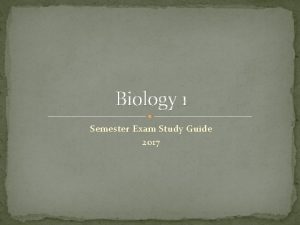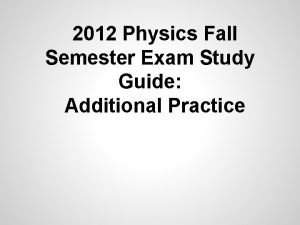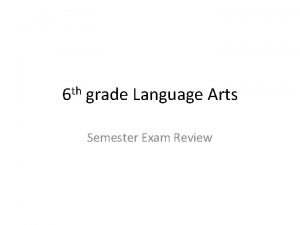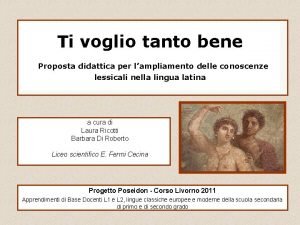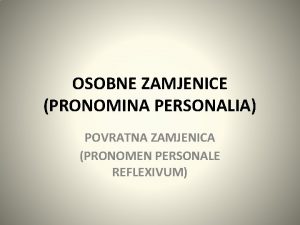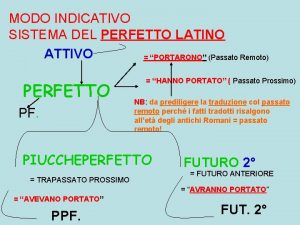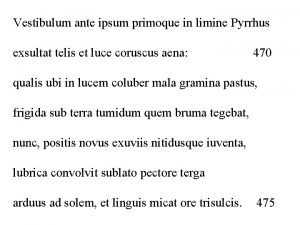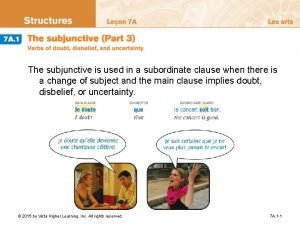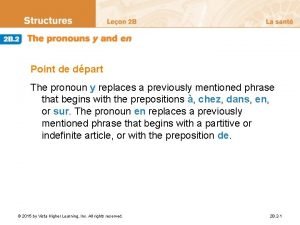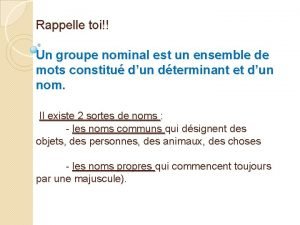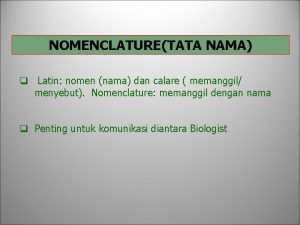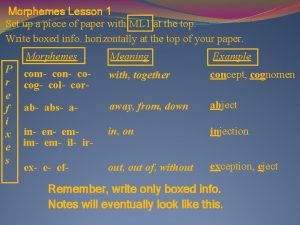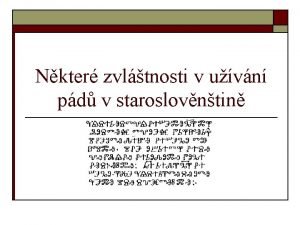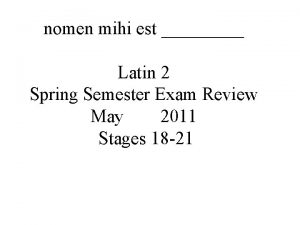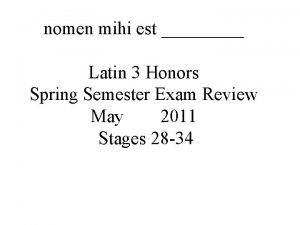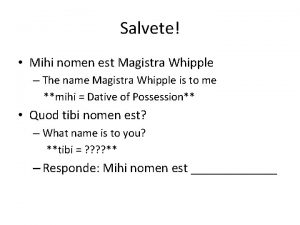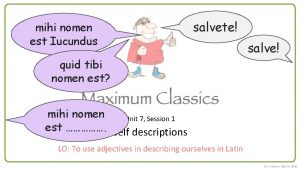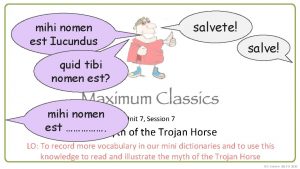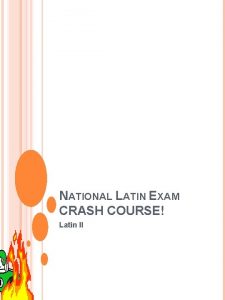nomen mihi est Latin 1 Spring Semester Exam














![13. What are the 3 degrees of adjectives [and adverbs]? • positive happy • 13. What are the 3 degrees of adjectives [and adverbs]? • positive happy •](https://slidetodoc.com/presentation_image_h2/f52961d45730e63dbae199e00c69c91c/image-15.jpg)































































- Slides: 78

nomen mihi est _____ Latin 1 Spring Semester Exam Review May 2011 Stages 8 -13

1. Name the parts of speech and define each. Noun – names of things Pronoun – takes the place of a noun Adjective – defines a noun or pronoun Adverb – describes the action of a verb Verb – shows action or state of being Preposition – expresses relationship between 2 nouns Conjunction – joins two sentences or phrases Interjection – an exclamation

2. Name the 5 noun cases and the uses of each • Nominative - subject, PN, PA • Genitive - shows possession • Dative - indirect object • Accusative - direct object • Ablative - special uses

3. How do you find the stem of a Latin noun? Drop the GENITIVE SINGULAR ending

4. How do you tell the declension to which a noun belongs? • Look at the • GENITIVE SINGULAR • 1 st = ae • 2 nd = i • 3 rd = is

5. What are the 1 st declension noun endings? puellae puellam puellae puellarum puellis puellas puellis

6. What are the 2 nd declension noun endings? amicus(puer, vir) amici amico amicum amico amici amicorum amicis amicos amicis

7. What are the 3 rd declension noun endings? mater matris matri matrem matres matrum matribus matres matribus

8. Pay special attention to: dative indirect object Quintus rosam Metellae dedit. dative of advantage Metella Felici togam invenit. dative object of special verbs Caecilius Holconio favit.

9. In what ways do Latin nouns and the adjectives which modify them agree? • Adjectives and the nouns they modify always agree in gender, number, and case. • The endings may not have the same spelling, but they are from the same gender, number and case locations on the endings charts.

10. What are the singular 1 st and 2 nd declension adjective endings? masculine singular feminine neuter malus mali malo malum malo malae malam mala malum mali malo malum malo

11. What are the Plural 1 st and 2 nd declension adjective endings? masculine mali malorum malis malos malis plural feminine malarum malis malas malis neuter mala malorum malis mala malis

12. Decline a rd 3 Declension Adjective singular celeris celeri celerem celeri celere celeris celeri celere celeri

12. Decline a rd 3 Declension Adjective plural celeres celerium celeribus celeres celeribus celeria celerium celeribus celeria celeribus
![13 What are the 3 degrees of adjectives and adverbs positive happy 13. What are the 3 degrees of adjectives [and adverbs]? • positive happy •](https://slidetodoc.com/presentation_image_h2/f52961d45730e63dbae199e00c69c91c/image-15.jpg)
13. What are the 3 degrees of adjectives [and adverbs]? • positive happy • comparative happier • superlative happiest

14. Give an example and translation of a regular adjective in the 3 degrees. clarus, -a, -um clear clarior, clarius clearer clarissimus, -a, -um clearest (1 st & 2 nd Declension)

15. Give an example and translation of a regular adjective in the 3 degrees. celer, celeris, celere swift celerior, celerius swifter celerrimus, -a, -um swiftest (3 rd Declension)

16. How is a 1 st & 2 nd declension adjective made into an adverb? • find the stem and add “e” • clarus: clare • pulcher: pulchre

17. Give examples of irregular adjectives in the comparative and superlative degrees. bonus melior optimus good better best malus peior pessimus bad worse worst magnus maior maximus great, large greater, larger greatest, largest parvus peius minimus smaller smallest

18. How is a 3 rd declension adjective made into an adverb? • find the stem and add “ter” or “iter” • celer: celeriter • acer: acriter

19. Give an example and translation of a regular adverb in the 3 degrees. clare clearly clarius more clearly clarissime most clearly

20. Irregular adverb in the 3 degrees. (positive degree ends in “r”) celeriter swiftly celerius more swiftly celerrime most swiftly

21. Irregular adverb in the 3 degrees. (stem changes) magne greatly maius more greatly maxime very greatly

22. Write the principal parts of porto, name the principal parts, find and name the stems, and show which tenses can be formed onto each stem. present indicative porto present infinitive perfect indicative perf. pass participle portare portavi portatus present perfect imperfect

23. How do you recognize the conjugation to which a verb belongs? Conjugation 1 st Prin. Pt 2 nd Prin. Pt 1 st 2 nd 3 rd rd 3 io th 4 o eo o io io are ēre ere ire-

24. Write the principal parts of the following verbs: porto, video, duco, capio, audio portare portavi portatum video videre vidi visum duco ducere duxi ductum capio capere cepi captum audio audire audivi auditum (see next 4 slides for close-ups)

present indicative (column 1) porto video duco capio audio

present infinitive portare videre ducere capere audire (column 2)

perfect indicative (column 3) portavi vidi duxi cepi audivi

perfect passive participle(column 4) portatus, -a, -um visus, -a, -um ductus, -a, -um captus, -a, -um auditus, -a, -um

(Review of last 4 slides) 25. Write the principal parts of the following verbs: porto, video, duco, capio, audio porto video duco capio audio portare videre ducere capere audire portavi vidi duxi cepi audivi portatum visum ductum captum auditum

26. How do you recognize the present tense? • verb looks more like the 1 st principal part • present stem + regular personal endings

27. Write the regular active personal endings o, m- I s - YOU t - HE, she, mus - WE tis - Y’ALL it nt - THEY

28. What do you have to remember about the agreement between verbs and their subjects? A verb and its subject agree in person and number

29. How do you translate the present tense (porto)? I carry I am carrying I do carry

30. Conjugate the following verbs in the present tense: porto, video, duco, capio, audio singular plural 1 st person 2 nd person 3 rd person

porto I carry porto portas portat 1 st Conjugation portamus portatis portant

video I see nd 2 Conjugation video videmus videtis videt vident

duco I lead rd 3 Conjugation duco ducimus ducitis ducit ducunt

capio I take rd 3 io Conjugation capio capimus capitis capit capiunt

audio I hear 4 th Conjugation audio audimus auditis audit audiunt

31. Give the principal parts of the irregular verbs: sum, possum, volo, eo, and fero. sum, esse, fui possum, posse, potui volo, velle, volui eo, ire, ii(ivi), itum fero, ferre, tuli, latum

32. Conjugate the irregular verbs in the present tense. sum possum volo eo fero See the following slides

sum I am sum es est sumus estis sunt

possum I am able possum potest possumus potestis possunt

volo I wish volo volumus vis vult volunt

eo I go eo imus is it eunt

fero fers fert I bear, bring ferimus fertis ferunt

33. How do you recognize the imperfect tense? “ba” just before the ending (=present stem + “ba” + personal endings)

34. How do you translate the imperfect tense (portabam)? I was carrying I used to carry I kept on carrying

35. Give examples of imperfect tense verbs. • • • ambulabam portabamus videbat ducebant capiebas audiebatis

36. Conjugate sum in the imperfect tense. eram - I was eramus - we were eras - you were eratis - y’all were erat - he was erant - they were

37. How do you recognize the perfect tense? • perfect stem • any one of the perfect endings

38. Write the perfect personal endings. i -I imus - we isti -you istis-y’all it-he, she, it erunt -they

39. How do you translate the perfect tense (portavi)? I carried I have carried I did carry

40. What is an infinitive? It is a verbal that is translated using “to” plus the verb meaning.

41. What is a preposition? A preposition indicates the relative position between its object and another noun in the sentence.

42. What two cases do the Latin prepositions govern? • accusative • ablative

43. List several prepositions and give their meanings and the case each governs. • + the Accusative: • ad - toward • trans - across • post - behind • ante - in front of

44. List several prepositions and give their meanings and the case each governs. • + the Ablative: • ab - away from • e, ex - out of • cum - with

45. Distinguish between the use of in + the accusative case and in + the ablative case. • + the Ablative & Accusative: at rest • in -in • sub - under motion into up under

46. Decline the personal pronoun in 1 st, 2 nd, 3 rd person. Give the English meaning of each Latin word. • see next slides

1 st, 47. Decline the personal pronoun in 2 nd, 3 rd person. Give the English meaning of each Latin word. singular plural nom. ego - I gen. mei - of me nos - we nostrum, nostri - of us dat. mihi - to/for me acc. me - me abl. me - by/with me nobis - to/for us nos - us nobis - by/with us

48. the personal pronoun in singular plural nom. tu - you gen. tui - of you vos - you vestrum, vestri - of you dat. tibi - to/for you acc. te - you abl. 2 ndperson. . te - by/with you vobis - to/for you vos - you vobis - by/with you

3 rd personal pronoun singular is eius ei eum eo ea eius ei eam ea id eius ei id eo

3 rd personal pronoun plural ei eorum eis eos eis eae earum eis eas eis ea eorum eis ea eis

49. Know the “indeclinables”: -que, et, sed, autem, tamen, postquam, -ne, num, nonne…etc • -que - and • et - and • sed- but • autem - however • tamen - nevertheless

50. Know the “indeclinables”: -que, et, sed, autem, tamen, postquam, -ne, num, nonne…etc • postquam - afterwards, after • -ne =a ? -mark • num - expects a “no” answer • nonne - expects a “yes” answer • Igitur - therefore

51. Know the “? -words”. quis, quid, ubi, quo, unde, quando, quot, cui, quocum, cur, etc. . . • quis - who quot - how many • quid - what cui - to whom • ubi - where, when cur - why • quo - to where quando - when • unde- from where • quocum - with whom

52. Be able to recognize and translate the vocative case noun. • Marcus: Marce • filius: fili • Caecilius: Caecili • meus: mi

53. Be able to recognize and translate the imperative mood verb. • voco, vocare, vocavi, vocatum • voca! call! • vocate! you all call!

54. Remember the special forms: placet + dative case placetne tibi? - que pueri puellaeque

55. Please gather up your old vocabulary pages and worksheet pages. Study the meanings of the Latin words and the English words derived from them.

56. Make a list of the characters you have met since stage 8 and write few notes about each.

57. Look over the culture information in the worksheet packets.

58. Study the culture topics: gladiators baths education elections 79 AD eruption of Vesuvius Roman Britian

59. Practice translating the stories in stage 13. You will have to translate on the final exam.

Fortunam bonam habeas! ---Magistra
 Gerundio e gerundivo
Gerundio e gerundivo Us history semester 2 final exam
Us history semester 2 final exam English 2 final exam review
English 2 final exam review Verbal irony def
Verbal irony def Difference between lytic and lysogenic cycle
Difference between lytic and lysogenic cycle World history semester 2 final exam review
World history semester 2 final exam review Earth science final exam answers
Earth science final exam answers Us history final exam semester 2
Us history final exam semester 2 Algebra 1 final review packet
Algebra 1 final review packet Spanish 1 answer key
Spanish 1 answer key Physics semester 1 final exam study guide answers
Physics semester 1 final exam study guide answers The first semester exam grade 10
The first semester exam grade 10 Zoology final exam review
Zoology final exam review English 12 final exam
English 12 final exam Biology 1st semester exam study guide
Biology 1st semester exam study guide Us history semester 1 final exam study guide answers
Us history semester 1 final exam study guide answers Accounting semester 1 exam
Accounting semester 1 exam Physics fall semester exam review
Physics fall semester exam review English 3 fall semester exam review
English 3 fall semester exam review Chemistry semester 1 exam review answers
Chemistry semester 1 exam review answers Post letnji
Post letnji World history semester 1 final exam study guide answers
World history semester 1 final exam study guide answers If a laboratory fire erupts, immediately
If a laboratory fire erupts, immediately Chemistry semester exam review
Chemistry semester exam review Apes semester 1 review
Apes semester 1 review English semester exam
English semester exam World history semester exam
World history semester exam Cast of spring, summer, fall, winter... and spring
Cast of spring, summer, fall, winter... and spring Spring summer autumn
Spring summer autumn Vivamus mea lesbia atque amemus analisi
Vivamus mea lesbia atque amemus analisi Pronomina relativa
Pronomina relativa Dami animas caetera tolle
Dami animas caetera tolle Pronomi personali latino
Pronomi personali latino Graecia capta ferum victorem cepit
Graecia capta ferum victorem cepit Da mihi animas, caetera tolle
Da mihi animas, caetera tolle Tum vero omne mihi visum
Tum vero omne mihi visum Kratke narodne priče
Kratke narodne priče Non mihi non tibi sed nobis
Non mihi non tibi sed nobis Videbar mihi praeceptis librorum non satis paruisse
Videbar mihi praeceptis librorum non satis paruisse Vanessa borrego
Vanessa borrego World history spring final exam review answers
World history spring final exam review answers Ouroborus cataphractus
Ouroborus cataphractus Il est douteux que le metteur en scène où est l’acteur.
Il est douteux que le metteur en scène où est l’acteur. Quel est le nom de la femelle du sanglier
Quel est le nom de la femelle du sanglier Papa est au garage? oui, il 1 of 1 est.
Papa est au garage? oui, il 1 of 1 est. Priére du matin et soir christ est vivant
Priére du matin et soir christ est vivant Tu es or vous etes
Tu es or vous etes Qu'est ce que c'est
Qu'est ce que c'est Total float= * 1 point lst-est lst-eft est-lft eft-lst
Total float= * 1 point lst-est lst-eft est-lft eft-lst Seul le silence est grand tout le reste n'est que faiblesse
Seul le silence est grand tout le reste n'est que faiblesse Chant mon dieu tu es grand tu es beau paroles
Chant mon dieu tu es grand tu es beau paroles Paroles mon dieu tu es grand tu es beau
Paroles mon dieu tu es grand tu es beau Je suis tu es il est elle est
Je suis tu es il est elle est Kochelsee
Kochelsee Qu'est ce que c'est
Qu'est ce que c'est Appuyez sur l’image qui est dans le bon sens
Appuyez sur l’image qui est dans le bon sens Le group nominal
Le group nominal Verbes d'etat
Verbes d'etat Qu'est-ce que c'est le subjonctif
Qu'est-ce que c'est le subjonctif Nomina transscripticia
Nomina transscripticia Expensilatio
Expensilatio Nomen transscripticium
Nomen transscripticium Nomen fälle bestimmen
Nomen fälle bestimmen Parisillabi terza declinazione
Parisillabi terza declinazione Partizip 1 als nomen
Partizip 1 als nomen Expensilatio
Expensilatio Nomen adjectivum
Nomen adjectivum Morphemes
Morphemes Tag genitiv
Tag genitiv Laudabile nomen domini
Laudabile nomen domini Immer wortart bestimmen
Immer wortart bestimmen 4 fälle von blume
4 fälle von blume Hilfsbereit nomen
Hilfsbereit nomen Genitiv kasus
Genitiv kasus Ilse kleberger
Ilse kleberger Beenden nomen
Beenden nomen Femininum maskulinum neutrum
Femininum maskulinum neutrum Ereignen nomen
Ereignen nomen Nomen mit z
Nomen mit z














